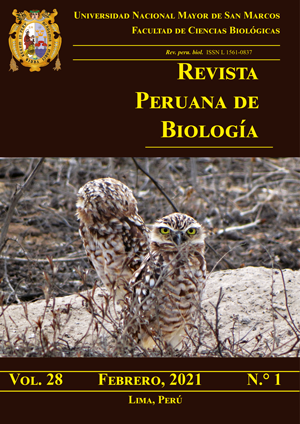Plant communities of the desert shrubland in the Tambo and Moquegua rivers basins in the southern Peru
DOI:
https://doi.org/10.15381/rpb.v28i1.17497Keywords:
Moquegua, phytosociology, Desert scrub, Opuntietea sphaericae, Oreocereo leucotrichi-Neoraimondietalia arequipensisAbstract
A study is presented on the floristic composition, phytosociological classification, ecology and bioclimatology of the plant communities in the desert environments of the Tambo and Moquegua river basins in the department of Moquegua, located in southern Peru at an elevation of about 1350 and 3200 m s.n.m. 94 phytosociological surveys were carried out in the field following the Braun-Blanquet method adapted by Montesinos, TWINSPAN 2.3 software was applied to classify vegetation and CANOCO 4.5 for the analysis of DCA with environmental variables. In the bioclimatic classification the Rivas-Martínez method was followed. The results show 181 species of flora are recorded, of which 32 are endemic and 121 are native. Vegetation analysis and classification result in the description of three associations, 5 new sub-associations and two communities within the new Ambrosio artemisioidis-Weberbauerocerion torataensis alliance belonging to the order Oreocereo leucotrichi-Neoraimondietalia arequipensis and class Opuntietea sphaericae. Two tropical bioclimatic classifications were found: Termotropical and Mesotropical in combination with four levels of humidity or ombroclimates: Ultrahyperarid, Hyperarid, Arid and Dry. The vegetation of the arid environments in southern Peru can become very varied and restricted to its river basins, they are dependent on extraordinary humid conditions that allow us to deduce the importance of conserving these desert ecosystems.
Downloads
Downloads
Additional Files
Published
Issue
Section
License
Copyright (c) 2021 Kent Jonathan Chicalla Rios

This work is licensed under a Creative Commons Attribution-NonCommercial-ShareAlike 4.0 International License.
AUTHORS RETAIN THEIR RIGHTS:
a. Authors retain their trade mark rights and patent, and also on any process or procedure described in the article.
b. Authors retain their right to share, copy, distribute, perform and publicly communicate their article (eg, to place their article in an institutional repository or publish it in a book), with an acknowledgment of its initial publication in the Revista Peruana de Biologia.
c. Authors retain theirs right to make a subsequent publication of their work, to use the article or any part thereof (eg a compilation of his papers, lecture notes, thesis, or a book), always indicating its initial publication in the Revista Peruana de Biologia (the originator of the work, journal, volume, number and date).


















